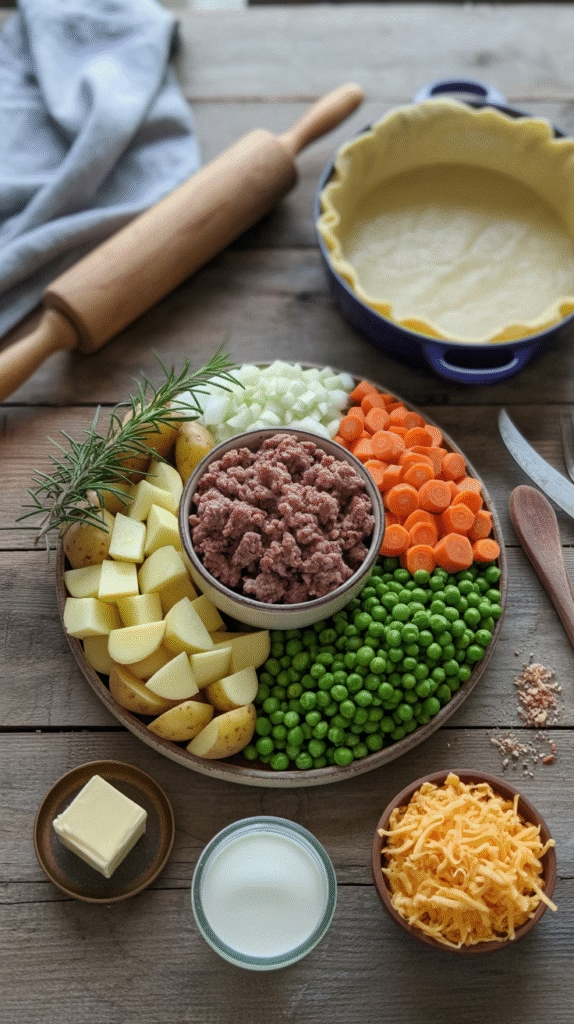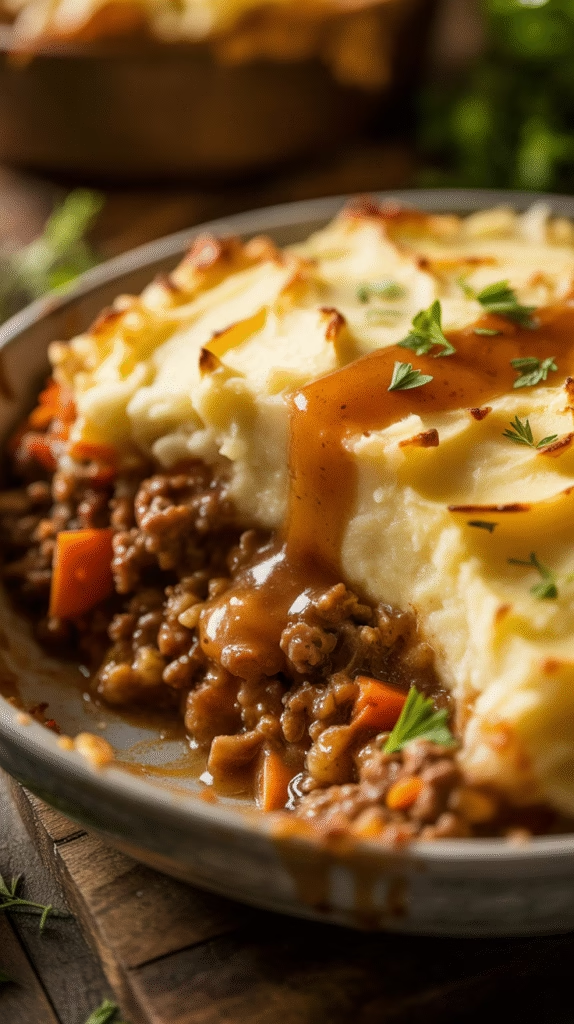There’s something magical about breaking through that golden-brown potato crust to reveal the savory, steaming filling beneath. Shepherd’s pie isn’t just food—it’s a warm hug on a plate, a taste of tradition, and quite possibly the ultimate comfort food. Today, I’m sharing my absolute favorite recipe that balances authentic flavors with modern techniques for the perfect family dinner.
What is Authentic Shepherd’s Pie?
Before we dive into the recipe, let’s clear up a common confusion. True shepherd’s pie is made with lamb (because shepherds tend sheep!), while cottage pie uses beef. This distinction dates back to 18th century Britain, where these hearty dishes were created as a clever way to use leftover roasted meat.
The dish has humble origins among rural British households, where economical, filling meals were essential. The combination of minced meat, gravy, vegetables, and a potato topping created a complete meal in one dish—perfect for hardworking families.
Over centuries, regional variations developed across the UK, Ireland, and eventually the world. Some versions incorporate Guinness in Ireland, while others might feature exotic spices or local vegetables depending on the region. Despite these variations, the core elements remain the same: ground meat (traditionally lamb), vegetables in rich gravy, topped with mashed potatoes and baked until golden.
What makes this comfort food endure in our modern era of exotic cuisines and diet trends? Simple: it delivers satisfaction on every level—nutritionally complete, texturally interesting, and packed with deep, developed flavors that satisfy our most basic cravings.

Essential Ingredients for the Perfect Shepherd’s Pie
The beauty of shepherd’s pie lies in its simple ingredients, transformed through proper technique:
For the meat filling:
- 2 lbs ground lamb (for authentic flavor)
- 2 medium onions, finely diced
- 3 carrots, diced into small cubes
- 2 celery stalks, finely chopped
- 4 cloves garlic, minced
- 2 tablespoons tomato paste
- 2 tablespoons Worcestershire sauce
- 1 cup red wine (optional but recommended)
- 2 cups high-quality beef or lamb stock
- 2 tablespoons all-purpose flour
- 2 bay leaves
- 2 sprigs fresh rosemary
- 4 sprigs fresh thyme
- 1 cup frozen peas
- 2 tablespoons olive oil
- Salt and freshly ground black pepper
For the potato topping:
- 3 lbs Yukon Gold potatoes (their buttery flavor and creamy texture are perfect)
- 6 tablespoons unsalted butter
- ½ cup warm whole milk
- ¼ cup sour cream
- 2 egg yolks (the secret to a beautiful golden crust!)
- Salt and white pepper
The choice of lamb is crucial for authentic flavor. Look for fresh ground lamb with about 15-20% fat content for the best flavor and moisture. If lamb isn’t available, high-quality ground beef can substitute (though technically, you’d be making cottage pie).
For potatoes, Yukon Golds provide the ideal balance of starchiness and creaminess. Russets work in a pinch but require more butter to achieve the same silky texture.
Equipment You’ll Need
Creating the perfect shepherd’s pie doesn’t require fancy equipment, but a few key tools make the process easier:
- Large, deep skillet or Dutch oven for preparing the filling
- 9×13 baking dish or large cast iron skillet for baking
- Potato masher or ricer (a ricer produces the fluffiest results)
- Sharp chef’s knife for vegetable prep
- Wooden spoon for stirring the filling
- Rubber spatula for folding and spreading potatoes
- Measuring cups and spoons
If you’re short on time, a food processor can speed up vegetable chopping, and an immersion blender can create ultra-smooth mashed potatoes. For presentation, piping bags and tips can create a decorative potato topping, though a simple fork to create texture works beautifully too.

Step-by-Step Shepherd’s Pie Recipe
Preparing the Filling
- Brown the meat properly: Heat olive oil in a large, deep skillet over medium-high heat. Add the ground lamb in batches (overcrowding prevents proper browning). Season each batch with salt and pepper, then cook until deep brown, about 5-7 minutes per batch. Transfer to a plate.
- Develop flavor base: In the same pan with the rendered fat, add onions, carrots, and celery with a pinch of salt. Cook over medium heat for 8-10 minutes until vegetables soften and onions become translucent. Add garlic and cook for another minute until fragrant.
- Build the gravy: Sprinkle flour over the vegetables and stir constantly for 2 minutes to cook out the raw flour taste. Add tomato paste and stir for another minute. Slowly pour in red wine (if using), scraping up all the flavorful brown bits from the bottom of the pan. Let wine reduce by half, about 3-4 minutes.
- Create rich sauce: Return the browned meat to the pan. Add stock, Worcestershire sauce, bay leaves, rosemary, and thyme. Bring to a gentle simmer, then reduce heat to low. Cover partially and cook for 25-30 minutes, stirring occasionally, until sauce has thickened and flavors have melded.
- Finish the filling: Taste and adjust seasoning with salt and pepper. Remove bay leaves and herb stems. Stir in frozen peas (they’ll cook perfectly in the oven). The filling should be moist but not soupy – if it’s too wet, simmer uncovered for a few more minutes.
Creating Perfect Mashed Potatoes
- Cook potatoes properly: Peel potatoes and cut into even 1-inch chunks. Place in a large pot and cover with cold water. Add 1 tablespoon salt. Bring to a boil, then reduce to a simmer and cook until fork-tender, about 15-20 minutes.
- Drain thoroughly: Drain potatoes in a colander, then return to the hot pot for 1-2 minutes, shaking occasionally to evaporate excess moisture.
- Mash with care: Use a potato ricer or masher (never a food processor, which makes gluey potatoes!) to create a smooth consistency.
- Add richness: Gently fold in warm milk, butter, and sour cream with a rubber spatula until just combined.
- Finish the topping: When slightly cooled, stir in egg yolks (which help achieve a golden-brown crust). Season with salt and white pepper to taste.
Assembly and Baking
- Preheat the oven to 375°F (190°C).
- Layer properly: Transfer the meat filling to a 9×13 baking dish or large cast iron skillet, spreading it evenly.
- Add the topping: Carefully spoon the mashed potatoes over the filling, starting from the edges (this “seals” the filling). Use a fork to create texture on the surface, which will form delicious crispy ridges.
- Bake to perfection: Place the dish on a baking sheet (to catch any bubbling over) and bake for 30-35 minutes until the topping is golden brown and the filling is bubbling at the edges.
- Rest before serving: Allow the shepherd’s pie to rest for 15 minutes before serving. This sets the filling and makes serving neater.
Common Mistakes to Avoid
Even experienced cooks can trip up when making shepherd’s pie. Here are key pitfalls to avoid:
- Skipping the browning step: Properly browning the meat creates the deep, rich flavor foundation. Don’t rush this step!
- Making watery filling: If your filling is too loose, your shepherd’s pie will collapse when served. Ensure proper reduction and thickening.
- Overworking the potatoes: Vigorous stirring or processing develops gluten, creating gluey rather than fluffy potatoes. Fold ingredients gently.
- Under-seasoning: Taste and adjust throughout the cooking process. Remember that potatoes absorb salt, so the topping needs adequate seasoning.
- Serving immediately from the oven: Without resting time, the filling will be too hot and runny. Patience yields neater servings.
Make-Ahead and Storage Tips
Shepherd’s pie is ideal for make-ahead meals:
- Prepare components separately: The filling can be made up to 2 days ahead and refrigerated. The potato topping can be made 1 day ahead (add egg yolks just before assembly).
- Assemble ahead: Complete pie can be assembled 1 day ahead, covered and refrigerated. Bring to room temperature before baking or add 15-20 minutes to baking time if cooking from cold.
- Freezing options: Freeze unbaked shepherd’s pie for up to 2 months. Thaw overnight in refrigerator before baking. Alternatively, freeze individual portions after baking for quick meals.
- Reheating properly: Refrigerated leftovers heat best in a 350°F oven for 20-25 minutes. Microwave works but may make the topping soggy.
Dietary Adaptations and Variations
Nearly everyone can enjoy shepherd’s pie with these adaptations:
- Gluten-free version: Replace flour with cornstarch (1 tablespoon) or gluten-free flour blend.
- Dairy-free topping: Use olive oil instead of butter, and unsweetened almond or oat milk instead of dairy milk. Nutritional yeast adds richness in place of cheese.
- Vegetarian/Vegan option: Replace lamb with a mixture of lentils and finely chopped mushrooms for meaty texture and flavor. Use vegetable stock and ensure all other ingredients are plant-based.
- Low-carb adaptation: Replace potato topping with cauliflower mash (drain thoroughly and add cream cheese for stability).
- Gourmet upgrades: Add exotic mushrooms to the filling, incorporate truffle oil into the potato topping, or finish with Gruyère cheese for a French twist.
Serving Suggestions and Pairings
Complete your shepherd’s pie meal with these perfect companions:
- Simple sides: A crisp green salad with vinaigrette or steamed green vegetables like peas or broccoli provide welcome freshness.
- Bread options: Crusty bread is perfect for soaking up extra gravy.
- Wine pairings: Medium-bodied reds like Côtes du Rhône, Chianti, or Malbec complement the rich flavors. For beer lovers, try English brown ale or Irish stout.
- Presentation ideas: Serve family-style from the baking dish for casual dinners. For guests, consider individual ramekins garnished with fresh thyme or a light dusting of smoked paprika.

Final Thoughts on Shepherd’s Pie
There you have it—your foolproof guide to creating the most delicious shepherd’s pie from scratch! This dish exemplifies how humble ingredients, when treated with care and proper technique, transform into something truly special.
Don’t hesitate to make this recipe your own by incorporating family favorites or seasonal vegetables. Some of my favorite variations include adding parsnips in winter, swapping peas for fava beans in spring, or incorporating leftover roasted lamb instead of ground meat.
The true magic of shepherd’s pie is its ability to bring people together. It’s unpretentious yet deeply satisfying food that speaks to something fundamental in all of us—the desire for comfort, nourishment, and tradition on a plate.
